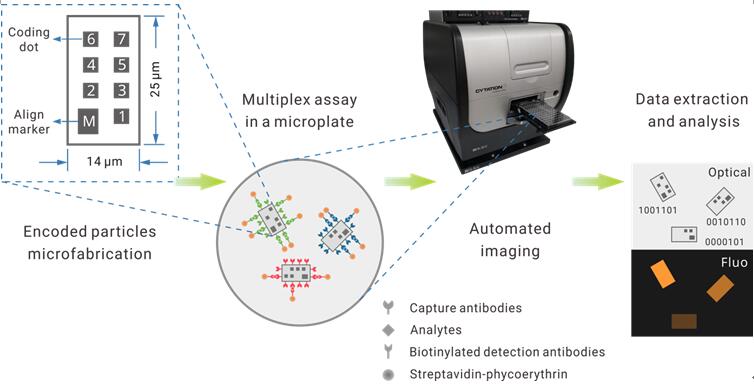
The passing decade saw the viral spread of the Quick Response (QR) code to every corner of the society. Such power comes from the digital transformation of the personal identity and other information. In a study published in Biosensors and Bioelectronics, a research team led by Prof. LI Jiong from Suzhou Institute of Nano-tech and Nano-bionics of the Chinese Academy of Sciences found a way to lever this power to detect many different biological signals at the molecular level. They are aiming to apply the proposed tech platform for better clinical diagnostics.
Immunoassay is the primary method to quantitate molecules of interest from clinical specimens. Most immunoassays are only capable of measuring one specific molecular analyte in a run. The monoplex assay format is considered insufficient in analyte throughput, and low efficient as it causes multiplied cost of assay time, reagents, labor, and sample volume when constructing a panel test.
Researchers attempted to tackle this hurdle using a nanotechnology approach. They reported a multiplexed suspension array platform based on graphically encoded silica microparticles. The particles are in micron size and in planar shape.
Using lithography, they engraved even smaller, yet visible "dots" on the particle surface as the coding bits, resembling the form of a common QR code. A total of seven bits per particle provides a max coding space of 128-plex.
For parallel detection of multiple analytes, a selected group of coded particles are added to the sample. After a standard fluorescent immunoassay workflow, an automated microscope takes both the brightfield and fluorescent photos of the particles, which are analyzed by a computer program to decode each particle and match the extracted signal intensity to it.
To evaluate this platform which they termed “GRASP assay”, researchers conducted parallel detection of up to six different cytokines in buffer solution. The analytical sensitivity reached subpicogram per ml level, while the dynamic range spans 4 logs. The performance was superior to many commonly-used monoplex enzyme immunoassays (EIA) such as ELISA.
They further demonstrated a clinical application by multiplex quantification of three auto-immune markers in serum from Type I diabetes patients. The sensitivity and specificity are equivalent to corresponding commercial diagnostic ELISA kits.
Compared to the widely-used bead cytometry multiplex assays depending on analog signals for decoding, the graphically-encoded GRASP assay provided a digital alternative which completely eliminates code mixing. It also avoids troublesome fluidics by using a standard multiwell plate as the assay vessel. Furthermore, the implement of semiconductor fabrication technology enables mass production of highly uniform particles in low cost.
For the next phase of the project, Dr. LI envisions to build a fully-automated in-vitro immunoassay system based on this technology.

Figure: Design of the graphically-recognizable array of suspension particles (GRASP) assay. (Image by SINANO)

86-10-68597521 (day)
86-10-68597289 (night)

86-10-68511095 (day)
86-10-68512458 (night)

cas_en@cas.cn

52 Sanlihe Rd., Xicheng District,
Beijing, China (100864)

